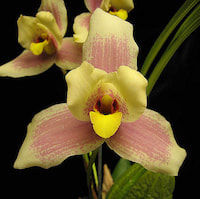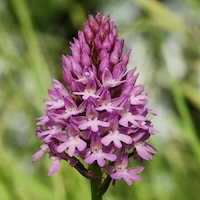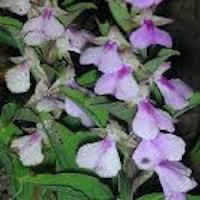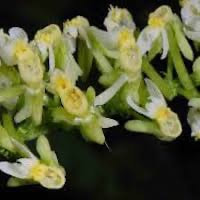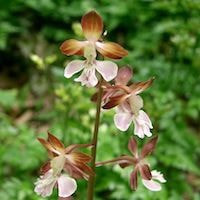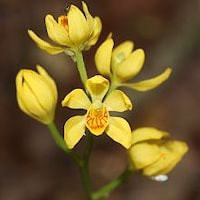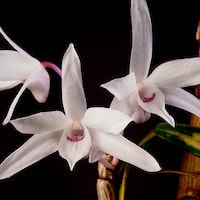Discover Oriental 8: The Ultimate Men's Fragrance
The Oriental 8 (Men) for Team building Perfume workshop offers a captivating fragrance blend, combining scented notes from various orchids and other aromatic elements:
- Native Singaporean Orchid notes:
- Lycaste Imschootiana - A natural hybrid with a great and slightly spicy, exotic scent. It thrives in diffused bright light and prefers cool to warm temperatures.
- Therapeutic Orchid notes:
- Anacamptis Rich - Found in grasslands in northern Iran, the Middle East, and southern and central Europe, this orchid's tubers are used to make salep, which was once considered an aphrodisiac and super-nutrient.
- Brachycorythis obcordata - A genus of over 30 terrestrial orchids found in Africa and tropical Asia, this species has culinary uses, with boiled pseudobulbs being eaten as food and leaves and shoots cooked as a vegetable.
- Calanthe davidii Franch. - This orchid is distributed from India across southern China to Taiwan and southern Japan. It has been used in Chinese Herbal Medicine for various purposes.
- Calanthe discolor Lindl. - Found in India, Bhutan, Bangladesh, and Myanmar, this orchid contains compounds that improve blood flow through the skin and promote hair growth. It is also used to treat various conditions, including skin ulcers and hemorrhoids.
- Cephalanthera falcata Lindl. - Found in several regions of China, the entire plant is known for its anti-heat properties and is used to treat sore throat and toothache.
- Dendrobium moniliforme (L.) Sw. syn. Dendrobium candidum Wallich ex Lindl., Dendrobium wilsonii Rolfe - This orchid, known by various names across different regions, has been developed as an ornamental plant in Japan. It contains compounds with antitumor and antiviral activity, making it a valuable medicinal material.
- Other scent notes: The fragrance blend is enhanced with a blend of several spicy notes, especially clove and black pepper, with a dash of orange, adding a delightful and invigorating touch to the overall aroma.
Other fragrance oils - Oriental 1, Oriental 2, Oriental 3, Oriental 4, Oriental 5, Oriental 6, Oriental 7, Oriental 8, Oriental 9, Oriental 10, Oriental 11, Oriental 12
Download the guided mediation that works best with this Orchid fragrance oil
| men_oriental_essential_oil_orchi_00008.mp3 | |
| File Size: | 113102 kb |
| File Type: | mp3 |
Therapeutic Blends for Men's Well-being
Contains Scented Notes of following in various proportions:
Native Singaporean Orchid notes: Lycaste Imschootiana
|
Lycaste Imschootiana - Used in Oriental 8 (Men) for Team building Perfume workshop
Lycaste imschootiana, a natural hybrid, is a captivating orchid species appreciated for its enchanting fragrance and exotic appeal. Let's delve into the characteristics, cultivation requirements, and its potential use in the perfume industry: Taxonomy and Origin: Lycaste imschootiana is a natural hybrid that was first discovered in 1893. It belongs to the Orchidaceae family, which is one of the largest and most diverse plant families. The genus Lycaste is known for its beautiful and fragrant flowers. The parent species that contributed to the formation of Lycaste imschootiana remain uncertain, but the hybridization process led to the creation of a unique and desirable orchid. Characteristics: Lycaste imschootiana is admired for its stunning flowers and captivating fragrance. The blooms are borne on elegant inflorescences, and the individual flowers showcase intricate patterns and colors. The fragrance of Lycaste imschootiana is described as great, with spicy and exotic undertones, adding to its allure. Cultivation Requirements: To thrive, Lycaste imschootiana requires specific growing conditions. It prefers diffused bright light, which means it should be exposed to filtered sunlight or grown under shade cloth to prevent direct exposure to intense sunlight. This orchid also thrives in temperatures ranging from cool to warm. Adequate airflow is essential to prevent fungal diseases and maintain the health of the plant. In terms of potting medium, Lycaste imschootiana benefits from well-draining materials such as orchid bark mix, which allows for proper aeration and prevents waterlogged roots. Regular watering is necessary, but it is crucial to allow the potting mix to dry out slightly between waterings to avoid overwatering, which can lead to root rot. Potential Use in Perfume Industry: The exquisite fragrance of Lycaste imschootiana makes it a valuable candidate for the perfume industry. Orchids have been prized for their aromatic properties for centuries. Extracting essential oils or fragrance compounds from orchids requires delicate and meticulous processes to capture the unique scents effectively. In the perfume industry, orchid scents are often used as base notes or heart notes in fragrances, adding depth and complexity to the overall aroma. The spicy and exotic undertones of Lycaste imschootiana's fragrance could be blended with other aromatic ingredients to create alluring and sophisticated perfumes. Oriental 8 (Men) and Perfume Workshop: The use of Lycaste imschootiana in Oriental 8 (Men) for team building perfume workshops indicates the orchid's significance as a fragrance source. Orchids, with their diverse and enchanting scents, have long been sought after for perfumery purposes. Perfume workshops can provide a unique and immersive experience for participants, allowing them to explore the art of creating fragrances and appreciating the diverse aromas found in nature. In conclusion, Lycaste imschootiana is a mesmerizing orchid hybrid cherished for its beautiful flowers and captivating fragrance. Its spicy and exotic scent, combined with its unique appearance, makes it a valuable addition to the world of perfumery. By providing the ideal growing conditions and harnessing the delicate aroma of this orchid, it can be used to create alluring and memorable fragrances, offering a delightful experience in the Oriental 8 (Men) team-building perfume workshops. |
Therapeutic Orchid notes:
|
Anacamptis Rich
Anacamptis is a genus of orchids that derives its name from the Greek word "anakamptein," which means "to bend back." The genus includes around a dozen species distributed across grasslands in various regions, including northern Iran, the Middle East, and southern and central Europe. These fascinating orchids have cultural and historical significance, especially regarding the use of their tubers for making salep, a traditional beverage once believed to be an aphrodisiac and super-nutrient throughout Europe. Taxonomy and Distribution: The genus Anacamptis belongs to the Orchidaceae family, one of the largest plant families. It comprises approximately twelve recognized species, each displaying unique characteristics and adaptations to their specific habitats. These orchids are native to diverse geographical regions, with a notable presence in grasslands across northern Iran, the Middle East, and southern and central Europe. Morphology and Adaptations: Anacamptis orchids exhibit intriguing floral structures and adaptations that contribute to their successful survival in their respective environments. Their flowers possess distinctive features, such as bending backward and displaying various colors and patterns, attracting pollinators such as bees, butterflies, and moths. The orchids rely on these pollinators for successful reproduction, facilitating cross-pollination and ensuring genetic diversity. Historical Use of Tubers for Salep: One of the most remarkable aspects of the Anacamptis genus is its historical use of tubers to make salep, a traditional beverage with purported aphrodisiac and super-nutrient properties. Salep has a long history in Europe, the Middle East, and parts of Asia, where it was highly prized for its perceived health benefits and culinary uses. Salep is made by grinding the dried tubers of certain orchid species, including those of the Anacamptis genus, into a fine powder. This powder is then mixed with milk or water and sweetened to create a nourishing and aromatic drink. In the past, salep was believed to have various medicinal properties, such as improving digestion, boosting vitality, and enhancing fertility. Due to these perceived benefits, it gained popularity as an aphrodisiac and tonic. Conservation Concerns: The popularity of salep and the high demand for the tubers of Anacamptis orchids led to overharvesting in some regions, resulting in a decline in their populations. As a consequence, some Anacamptis species are now listed as threatened or endangered, raising conservation concerns for these beautiful and ecologically important orchids. Modern Perspectives: Today, the consumption of salep has declined significantly due to a better understanding of orchid conservation and sustainable harvesting practices. In many regions, the commercial salep industry has shifted to using other plant-based substitutes. Efforts are being made to promote responsible harvesting and cultivation of orchids to protect natural populations and ensure their conservation. In conclusion, Anacamptis is a fascinating genus of orchids with a rich history in human culture, especially in its historical use for making salep, a traditional beverage believed to have aphrodisiac and super-nutrient properties. However, the popularity of salep and overharvesting have led to conservation concerns for some Anacamptis species. Today, efforts are being made to promote sustainable practices and protect these unique and beautiful orchids for future generations to admire and appreciate. |
|
Brachycorythis obcordata
Chinese name: Baoye Lan Nepali name: Gangdol Common name: Heart shaped Brachycorythis Brachycorythis is a genus of over 30 predominantly terrestrial orchids that are distributed in Africa and tropical Asia. The name "Brachycorythis" is derived from the Greek words "brachy" meaning "short" and "korys" meaning "helmet," referring to the shape of the flowers. One species within this genus is Brachycorythis obcordata, commonly known as "Heart shaped Brachycorythis." It is found in various regions including India, Bhutan, Bangladesh, and Myanmar. The flowering period varies slightly depending on the specific location, occurring from June to August in Bangladesh, July to August in Nepal, and July to September in Bhutan. Traditional Uses: In the regions where it is found, Brachycorythis obcordata has been utilized for various medicinal and culinary purposes. The roots of the plant are known for their astringent and expectorant properties, making them useful for treating conditions such as diarrhea and respiratory issues. In Nepal, the root is used as a tonic to promote general well-being. Culinary Uses: Interestingly, some parts of Brachycorythis obcordata are also consumed as food. Boiled pseudobulbs, which are thickened, storage organs, are eaten as a source of sustenance. Additionally, the leaves and shoots of the plant are cooked and used as a vegetable in local cuisine. Conservation Status: As with many orchid species, Brachycorythis obcordata and other members of the genus face conservation challenges due to habitat loss and over-harvesting. Deforestation, agricultural expansion, and urbanization have resulted in the decline of natural habitats for these orchids. Additionally, the collection of wild orchids for horticultural purposes and traditional medicinal practices can further threaten their populations. Conservation Efforts: Recognizing the importance of conserving these beautiful and ecologically valuable plants, efforts are being made to protect the habitats of Brachycorythis obcordata and other orchid species. Conservation organizations, governments, and local communities are working together to establish protected areas and implement sustainable harvesting practices. Additionally, cultivation and propagation techniques are being developed to reduce the demand for wild-collected orchids and support their conservation in their natural habitats. In conclusion, Brachycorythis obcordata, also known as "Heart shaped Brachycorythis," is a species of orchid found in Asia. It has a long history of traditional use, with its roots being valued for their medicinal properties, and various parts of the plant serving as a source of food. However, like many orchids, this species faces conservation challenges due to habitat loss and over-collection. Conservation efforts are underway to protect these unique orchids and ensure their survival for future generations to appreciate and benefit from. |
|
Calanthe davidii Franch.
Chinese name: Jianyexiaji Lan (sword leaf prawn spine orchid) Changyegenjie Lan Chinese medicinal name: Mayaqi (the name is shared with Calanthe alpina) Calanthe davidii Franch., also known as the "sword leaf prawn spine orchid" or "Changyegenjie Lan" in Chinese, is a species of orchid found in various regions from India to southern China, Taiwan, and southern Japan. Unfortunately, it is believed that this species may now be seriously endangered or even extinct in the Himalayas. Description: The flowers of Calanthe davidii are numerous and densely crowded, with random orientations. The plant exhibits a beautiful and intricate flowering structure that is characteristic of orchids. The species is morphologically similar to Calanthe alpina, and the Chinese name "Mayaqi" is used to refer to both C. davidii and C. alpina in Chinese Herbal Medicine. Geographic Distribution: Calanthe davidii is native to a wide geographical range, extending from India in the west, across southern China to Taiwan and southern Japan in the east. Historically, it was found in the Himalayas, but there are concerns about its survival in that region due to the loss of its natural habitats and other environmental pressures. Herbal Usage: In traditional Chinese Herbal Medicine, the term "Mayaqi" is used to encompass both Calanthe davidii and Calanthe alpina. These orchids have a range of traditional medicinal uses. However, detailed information regarding the specific therapeutic applications and constituents of "Mayaqi" in traditional medicine is not widely available in the public domain. Conservation Status: As mentioned earlier, there are concerns about the conservation status of Calanthe davidii in its natural habitats. The loss of suitable habitats due to deforestation, urbanization, and other human activities, as well as the over-collection of wild plants, have contributed to the decline in its populations. In the Himalayas, where it was once found, there are indications that the species may be at risk of extinction. Conservation Efforts: Conservation efforts are essential to safeguard the survival of Calanthe davidii. The protection and restoration of natural habitats, along with the implementation of sustainable harvesting practices, are crucial steps in ensuring the conservation of this species. Additionally, initiatives to raise awareness about the importance of preserving native orchid species and their ecosystems can play a significant role in their conservation. In conclusion, Calanthe davidii Franch. is a beautiful and ecologically valuable orchid species found in India, southern China, Taiwan, and southern Japan. However, its survival is threatened by habitat loss and other human-induced pressures, and it may now be seriously endangered or extinct in the Himalayas. Efforts to conserve this species and its habitat are essential to ensure its continued existence and to preserve its role in traditional Chinese Herbal Medicine and the natural ecosystems it inhabits. |
|
Calanthe discolor Lindl.
Chinese names: Xiaji Lan (prawn spine orchid) Chinese medicinal names: Jiuzilianhuancao (nine united sons flowering herb)—this name also refers to Calanthe tricarinata; zhu chuan zhu (string of beads); ye baiji (night white chicken); Roulainhuan (meat in circles); Jiujiechong (nine segment bug); Yichuanniuzi (string of buttons). Calanthe discolor Lindl., commonly known as the "prawn spine orchid" or "Xiaji Lan" in Chinese, is a species of orchid with a wide range of traditional medicinal uses. It has various Chinese names, including "Jiuzilianhuancao" (nine united sons flowering herb), "zhu chuan zhu" (string of beads), "ye baiji" (night white chicken), "Roulainhuan" (meat in circles), "Jiujiechong" (nine segment bug), and "Yichuanniuzi" (string of buttons). Phytochemistry: Calanthe discolor contains several compounds that have been found to improve blood flow through the skin and promote hair growth. Some of the important compounds identified in this orchid are:
Herbal Usage: In traditional Chinese medicine, Calanthe discolor is used as a medicinal herb. It is collected mainly from Huadong (in Guangdong Province), China. Different parts of the plant, including the entire plant, roots, and stems, are utilized for their medicinal properties. The herb is believed to possess properties that can dissolve extravasated blood and improve circulation in the body. It is often used to treat conditions such as abscesses, scrofula, rheumatism, bone pain, and traumatic injuries. Calanthe discolor is also employed to address skin ulcers and hemorrhoids. The orchid's traditional medicinal uses are rooted in Chinese herbal medicine, where it is valued for its potential to promote overall well-being and alleviate various health conditions. However, it is essential to note that while traditional uses hold cultural significance, further scientific research is necessary to fully understand and validate the therapeutic effects of Calanthe discolor. In conclusion, Calanthe discolor Lindl. is a species of orchid with a wide array of traditional medicinal uses in Chinese herbal medicine. Its diverse phytochemical profile, including calanthoside, glucoindican, calaliukiuenoside, calaphenanthrenol, and other compounds, contributes to its potential health benefits. As with many traditional herbal remedies, scientific research is ongoing to explore and confirm the specific therapeutic properties of Calanthe discolor. |
|
Cephalanthera falcata Lindl.
Chinese names: Jin Lan (gold orchid), Lianyetourui Lan (pistal above sickle leaf orchid) Chinese medicinal name: Jin Lan (gold orchid) Cephalanthera falcata Lindl., commonly known as the "gold orchid" or "Jin Lan" in Chinese, is a species of orchid with traditional medicinal uses. It is also referred to as "Lianyetourui Lan," which translates to "pistil above sickle leaf orchid" in Chinese. Herbal Usage: Cephalanthera falcata is found in various regions of China, including Hubei, Hunan, Guangdong, Guangxi, Yunnan, and Sichuan. In traditional Chinese medicine, the entire plant of Cephalanthera falcata is believed to possess anti-heat properties and is used to relieve fever. The herb is commonly used to treat conditions such as sore throat and toothache, where it is believed to have soothing and cooling effects. The specific traditional medicinal applications of Cephalanthera falcata are rooted in Chinese herbal medicine, where it is valued for its potential to alleviate symptoms of heat-related conditions and provide relief from fever and inflammation. It is essential to note that traditional uses of Cephalanthera falcata, like many other herbal remedies, have cultural significance and historical roots. However, scientific research is necessary to fully understand the pharmacological effects and safety profile of this orchid in medical applications. As with any herbal medicine, it is essential to consult with qualified healthcare professionals or traditional Chinese medicine practitioners before using Cephalanthera falcata or any other herbal remedy. This ensures that the herb is used appropriately and safely, taking into consideration individual health conditions and potential interactions with other medications. In summary, Cephalanthera falcata Lindl. is a species of orchid with traditional medicinal uses in Chinese herbal medicine. Referred to as "Jin Lan" or "gold orchid" in Chinese, it is believed to possess anti-heat properties and is used to relieve fever, sore throat, and toothache. Further scientific research is needed to explore the specific therapeutic properties and potential health benefits of Cephalanthera falcata. |
|
Dendrobium moniliforme (L.) Sw. syn. Dendrobium candidum Wallich ex Lindl., Dendrobium wilsonii Rolfe
Chinese name: Shihu (Noble Orchid), Shilan (stone orchid), Xijingshihu (thin-stemmed Dendrobium), Xiaoshihu (small Dendrobium), Xiaohuancao (small whorled herb), Jizhua Lan (chicken claw orchid), Jingchacao Tongpi Lan (copper orchid), Tongpishihu (copper Dendrobium) Medicinal names: Shihu, Huan cao (whorled herb), (gold hairpin grass), Erhuancao (ear- ring herb), Xicao (slender herb), Huangcao (yellow herb), Xihuancao (slender whorled herb), Xiaojingcha (small gold hairpin) Taiwanese names: Bai Shi Hu (white Dendrobium), Shi Hu (medicinal Dendrobium), Jie Gu Cao (fixing fracture Dendrobium) Japanese name: Sekkoku Korean name: Seok gok Dendrobium moniliforme (synonyms: Dendrobium candidum, Dendrobium wilsonii) is a species of orchid that holds significant cultural and medicinal value in various Asian countries. It is commonly known as "Shihu" (Noble Orchid) in Chinese and has several other names in different languages, such as "Shilan" (stone orchid), "Xijingshihu" (thin-stemmed Dendrobium), "Xiaoshihu" (small Dendrobium), and more. Ornamental and Cultural Significance: Dendrobium moniliforme has been cultivated as an ornamental plant in Japan since the early 19th century, making it a highly desirable and admired species in Japanese culture. It is known for its beautiful and delicate flowers, making it a popular choice for ornamental gardens and floral displays. Phytochemistry: One of the most important compounds isolated from Dendrobium moniliforme is denbinobin. Denbinobin has shown unique antitumor activity and has also demonstrated effectiveness against the AIDS virus. Another promising compound is moniliformedequinone, which has potent cytotoxic activity against hormone-resistant prostate cancer cells in vitro. It induces cellular glutathione depletion, leading to DNA damage response and cell-cycle arrest at the S-phase, preventing cell multiplication, and triggering a caspase cascade that culminates in apoptosis. Medicinal Usage: In traditional herbal medicine, Dendrobium moniliforme is considered a classic "shihu" and is highly valued. The pseudobulb of the plant is used for various medicinal purposes, including correcting body heat, treating conditions like haemoptysis (coughing up blood), thirst, malaise, and anorexia, and improving body fluids. Japanese and Korean herbalists also use it to address night sweats, weakness, anorexia, lumbago, and impotence. Dendrobium moniliforme has been found to inhibit the release of histamine and aldose reductase, which may contribute to its medicinal properties and potential therapeutic effects. It is important to note that traditional uses of Dendrobium moniliforme are deeply rooted in the cultural practices of Asian countries. While some of its compounds have shown promising effects in scientific studies, more research is needed to fully understand its pharmacological properties and potential applications in modern medicine. As with any herbal remedy, it is crucial to seek guidance from qualified healthcare professionals or traditional medicine practitioners before using Dendrobium moniliforme or any other herbal product. This ensures safe and appropriate usage, taking into consideration individual health conditions and potential interactions with other medications. |
Other scent note
Blend of several spicy notes especially clove and black pepper with dash of orange
Scentopia Library Reference ingredient
Musk - Check details at Scentopia's scent library
Join Scentopia's wonderful orchid scent crafting, fragrance tour, bridal shower or corporate team building which includes perfume making onsite and offsite, beach activities and more. We also serve primary school learning journey, secondary students and pupil on industrial excursions. Know more about our orchids perfume bar or therapeutic orchid scents and other wellness aromas. Conatct Perfume workshop or book a scent crafting session here.
